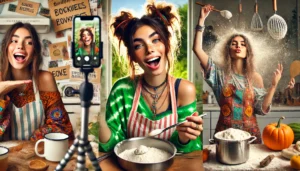Influencers GoneWild: The Personality Behind the Movement and Its Impact
In the world of social media, influencers have evolved from being mere content creators to global personalities who shape trends, influence purchasing decisions, and even impact societal norms. However, a new wave of influencers has emerged that has taken the internet by storm—Influencers GoneWild. These individuals defy traditional influencer norms, embracing raw authenticity, rebellious personalities, and controversial content. Their personalities are often bold, unfiltered, and unpolished, which sets them apart from the highly curated world of mainstream influencers.
But what exactly makes influencers gonewild so captivating? How do their wild personalities affect their followers psychologically? How are businesses leveraging these influencers, and what risks and rewards come with collaborating with them? In this article, we will explore the various facets of the Influencers GoneWild movement, diving deep into their personalities, the psychological effects on their followers, how they impact the world of influencer marketing, and the business opportunities they offer.
1. The Unique Personality of Influencers GoneWild: What Sets Them Apart?
1.1 Defying Traditional Beauty Standards
One of the most defining features of wild influencers is their rejection of traditional beauty standards. In an industry often defined by flawless faces and Instagram-perfect bodies, influencers gonewild embrace authenticity over perfection. These influencers defy societal norms about what beauty should look like, often embracing body positivity, unique fashion choices, and unfiltered images.
Example: Influencers like Lizzo and Ashley Graham challenge traditional beauty standards by promoting body acceptance and rejecting Photoshop. They proudly display their bodies, showing off their cellulite, stretch marks, and other natural features that many influencers typically hide. This not only empowers their audience to embrace their bodies but also signals to the world that beauty can take many forms.
Breaking Away from Filters: Unlike many influencers who rely heavily on filters and photo editing, wild influencers prefer showcasing their unretouched photos. Their fans appreciate the transparency, knowing that the influencers they follow are not selling an unattainable, idealized version of themselves.

1.2 Celebrating Imperfection and Vulnerability
While traditional influencers are often seen as living picture-perfect lives, influencers gonewild embrace imperfection and vulnerability. These influencers are known for opening up about their struggles, flaws, and the less glamorous sides of their lives.
Example: Influencers like Chrissy Teigen and Dwayne “The Rock” Johnson share personal struggles, such as mental health issues, weight fluctuations, and past failures. This honesty resonates with their followers, who see that these individuals are not just perfect beings on a pedestal but real people who face challenges just like anyone else.
Relatability: By sharing their personal stories and struggles, wild influencers create deeper connections with their followers. Audiences are drawn to their authenticity and feel more connected to them because they don’t hide behind a façade.
1.3 Humor and Rawness: The Fun Side of Rebellion
A core trait of influencers gonewild is their sense of humor and their willingness to use it in unconventional ways. These influencers often bring humor into serious conversations, making content more engaging, approachable, and relatable. Their humor often carries a rebellious undertone, which serves to challenge social norms and stereotypes.
Example: Ryan Reynolds and Billie Eilish are masters of using humor to entertain and communicate messages. Their ability to use sarcasm, wit, and self-deprecation adds a layer of relatability that resonates deeply with their followers, especially younger audiences who appreciate rebellion in a fun, non-confrontational manner.
Rebellious Humor: Many influencers gonewild use humor to challenge societal expectations. This may involve poking fun at current events, celebrities, or even societal structures. Their witty commentary is both entertaining and subversive, pushing boundaries while keeping the audience engaged.
1.4 Empowerment through Self-Expression
At the heart of the influencers gonewild movement is the message of self-expression. These influencers encourage their followers to embrace who they truly are and to reject the idea of conforming to society’s expectations. Their content often revolves around expressing individuality and finding strength in being different.
Example: Jameela Jamil has long been a champion for embracing one’s true self, speaking out against toxic beauty standards and promoting self-love. She encourages her followers to embrace their flaws and imperfections, challenging societal norms that tell them to be something they’re not.
Encouraging Non-Conformity: Wild influencers also reject conventional gender roles, allowing their followers the freedom to express themselves in ways that don’t conform to traditional gender expectations. This celebration of diversity gives their audience the freedom to explore their own identities.
1.5 Authentic Connections with Followers
Unlike traditional influencers who maintain a professional distance, wild influencers often engage with their followers in more meaningful and authentic ways. They respond to comments, share personal experiences, and create a sense of community among their fan base.
Example: Selena Gomez, who has been open about her struggles with mental health, uses her platform to connect with followers on a deeper level. By engaging with fans on a personal level, she cultivates a sense of loyalty and trust that goes beyond superficial content creation.
Two-Way Communication: Many wild influencers regularly engage with their audience through live streams, Q&A sessions, and personal stories. This direct interaction fosters a sense of intimacy and creates a bond that is harder to achieve through traditional influencer marketing.
1.6 Rejection of Traditional Influencer Norms
The most rebellious aspect of influencers gonewild is their refusal to adhere to traditional influencer norms. They don’t simply promote products or maintain a polished online image—they break free from the constraints of commercial influence, creating content that is unapologetically personal.
Example: Many wild influencers opt for non-traditional brand partnerships, often aligning themselves with causes and products that reflect their values rather than focusing on major corporate endorsements. This freedom allows them to create content that feels more genuine and true to themselves, which in turn resonates deeply with their audience.
2. The Psychological Impact of Wild Influencers on Their Followers
2.1 The Power of Authenticity in Connection
One of the most significant impacts of influencers goneiwild on their followers is the psychological connection that authenticity fosters. By being raw, vulnerable, and real, these influencers create an environment where their audience feels seen, heard, and understood.
Relatability Over Perfection: As wild influencers reject perfectionism and embrace flaws, their followers feel more comfortable with their own imperfections. This leads to increased self-acceptance and improved mental health outcomes for many.
Sense of Belonging: When followers see an influencer being their true self, it creates a sense of belonging among a community of like-minded individuals. This sense of community provides emotional support and validation, especially for those who may feel isolated or disconnected in their real lives.
2.2 Psychological Comfort and Emotional Support
By openly sharing their struggles with mental health, body image, and personal challenges, wild influencers serve as emotional support figures for their followers. This creates a sense of psychological comfort, knowing that someone they admire has gone through similar experiences and survived.
Promoting Mental Health Awareness: Influencers like Selena Gomez and Demi Lovato speak openly about their battles with mental health, which encourages their audience to seek help and prioritize their well-being. Their openness normalizes conversations around mental health, making it easier for followers to open up about their own struggles.
Influencers as Emotional Anchors: For many followers, wild influencers provide a sense of stability in times of emotional distress. These influencers often act as role models who show that it’s okay to seek help and take care of your mental health.
2.3 Empowering Followers to Speak Out
Many wild influencers use their platforms to speak out against social injustices, inequalities, and political issues. By speaking up, they empower their followers to find their own voices and advocate for what they believe in.
Example: Emma Watson, known for her work with HeForShe, encourages her followers to stand up for gender equality and women’s rights. Her activism empowers others to join movements for social change, creating a ripple effect of positive action.
Activism and Advocacy: Wild influencers encourage their audience to challenge the status quo and use their voices to advocate for marginalized groups. This advocacy contributes to social change and encourages followers to become more politically and socially engaged.

2.4 Encouraging Self-Love and Acceptance
Through their unapologetic embrace of self-love, wild influencers encourage their followers to accept and love themselves as they are, flaws and all.
Self-Care Practices: Many wild influencers share self-care routines and wellness practices that prioritize mental and physical well-being. This encourages their followers to practice self-compassion and focus on their personal growth and happiness.
Combating Negative Body Image: Wild influencers combat negative body image by showcasing all body types and emphasizing the importance of self-love. This can help followers overcome harmful societal standards and embrace a healthier, more positive view of their own bodies.
2.5 Challenging Social Norms and Expectations
The psychological impact of wild influencers extends beyond personal empowerment—they also challenge the norms and expectations set by society. By questioning societal standards on beauty, gender, and success, wild influencers encourage their followers to do the same.
Breaking Free from Gender Norms: Influencers like Troye Sivan and Janelle Monáe have used their platforms to challenge traditional gender roles, advocating for gender fluidity and non-binary identities. This contributes to a more inclusive society where individuals are free to express their gender identity however they choose.
Rebellion Against Conformity: Wild influencers inspire their audience to reject conformity and embrace individuality, leading to a more diverse, accepting, and creative society.
3. Influencers Gone Wild and Brand Marketing: Changing the Game
3.1 Brand Alignment with Authenticity
In recent years, brands have realized that authenticity is crucial for connecting with consumers. As wild influencers thrive on their unfiltered personalities, they create an opportunity for brands to align with their message of authenticity, creating more genuine connections with their audiences.
Authentic Product Endorsements: Brands like Patagonia and Ben & Jerry’s have partnered with wild influencers to promote sustainability and social justice. These partnerships are not just about selling products—they are about supporting causes that resonate with both the influencer and their audience.
Consumer Trust: As consumers become more skeptical of traditional advertising, wild influencers provide a level of trust and relatability that other influencers cannot. Brands that partner with them benefit from increased trust and loyalty from their audience.
3.2 The Appeal of Imperfection in Advertising
Traditional advertising has long relied on polished, perfect images of products and lifestyles. However, wild influencers are changing the game by promoting imperfections and real-life experiences, which appeal to consumers looking for honesty over perfection.
Real vs. Ideal: Brands that embrace the wild influencer approach recognize that their consumers crave authenticity over idealized versions of reality. By showcasing real people with real flaws, brands create a more genuine connection with their audience.
3.3 How Brands Use Wild Influencers for Campaigns
Brands today have to adapt quickly to the demands of a new generation of consumers. Wild influencers present a fresh opportunity for brands to market in a more authentic and daring way. They offer companies the chance to tap into niche audiences who may otherwise be alienated by traditional advertising.
Example: When Fashion Nova partnered with influencers like Cardi B and Kylie Jenner, they capitalized on the influencers’ rebellious and bold personalities. This helped the brand not only to sell products but also to position itself as an influencer-driven fashion brand that embraces individuality and diverse styles.
Collaborative Content: Brands also collaborate with wild influencers to create unique content that resonates with followers. Whether it’s through funny, raw, or controversial content, these collaborations push the boundaries of traditional marketing and have a greater impact because they feel more genuine to audiences.
3.4 The Importance of Niche Audiences in Wild Influencer Marketing
Wild influencers often have highly specific and niche audiences. Rather than trying to appeal to everyone, these influencers target specific demographics based on shared values or interests, making their content more powerful and relevant.
Example: Vegan influencers who openly promote plant-based diets and cruelty-free products have created a strong following in a niche market that brands like Beyond Meat or Oatly can tap into. These followers are likely to be loyal to influencers and trust their product endorsements because they align with their personal values.
Targeting Smaller, Engaged Audiences: Unlike mainstream influencers with millions of followers, wild influencers may have fewer followers but higher engagement rates. Their audiences tend to be more invested in their content, which means that a brand endorsement from a wild influencer often carries more weight than one from a traditional influencer.

3.5 Ethical Dilemmas in Influencer Marketing
While the wild, rebellious nature of these influencers may appear to be a perfect match for edgy brands, the question of ethics looms large. The authenticity of wild influencers can be both a strength and a challenge. Some brands may struggle with how to align their products with influencers who might often flirt with controversy or challenge societal norms.
Example: Brands that promote ethical consumption, like Toms or The Body Shop, may find it difficult to partner with influencers whose content or behavior might be viewed as counterproductive to their brand values, such as promoting excessive consumption or irresponsible actions.
Balance in Collaboration: For brands working with wild influencers, it’s crucial to find the balance between standing behind authenticity and maintaining brand integrity. Companies need to evaluate the long-term effects of associating with influencers whose brand identities might shift rapidly or who might become embroiled in scandal.
3.6 Long-Term Relationships with Wild Influencers
Unlike traditional influencers, who often maintain a professional, detached relationship with their brands, wild influencers tend to build long-term relationships with their followers—and by extension, with the brands they endorse. This creates a unique opportunity for companies to engage in long-term partnerships rather than short-term campaigns.
Deep Brand Loyalty: Because wild influencers connect with their followers on an emotional and authentic level, their endorsement often leads to deep brand loyalty. When a wild influencer promotes a product, followers see it not just as a paid partnership, but as a genuine recommendation from someone they admire.
Example: Brands like Glossier have built their entire marketing strategy around loyal influencers, allowing them to stay relevant in an ever-evolving market. Their partnerships with influencers reflect their ethos of authenticity, which helps foster stronger connections with their audience.
4. The Business of Wild Influencers: From Merchandising to Brand Ambassadorships
4.1 Expanding Brand Opportunities Through Merchandising
Many wild influencers use their platform to launch their own products and merchandise, capitalizing on their unique personal brand. This can include anything from clothing lines to beauty products, fitness gear, or even home decor. Their followers, who have built emotional connections with them, are eager to purchase products that reflect the influencer’s personality and lifestyle.
Example: Kylie Jenner’s beauty line, Kylie Cosmetics, is an example of how a wild influencer can successfully launch and sustain a profitable business. Kylie’s authenticity, combined with her boldness and unapologetic personality, helped her create a brand that speaks to millions of followers globally.
Influencer Merchandising: Many influencers use their social media following as a springboard for launching merchandise. This not only strengthens their brand but also builds a direct business model where they control the narrative and maximize revenue. Influencers like Emma Chamberlain have turned their personal brand into a booming business by offering exclusive merchandise and collaborations.
4.2 Brand Ambassadorships: The Road to Influencer Income
For wild influencers, becoming a brand ambassador for various products or services is another lucrative avenue. These partnerships are more than just one-off promotions—they reflect the long-term relationship between the influencer and the brand.
Example: Rihanna’s collaboration with Fenty Beauty is a prime example of a brand ambassador deal that benefited both the brand and the influencer. Rihanna’s bold, rebellious personality helped the brand build a cult following among people of all skin tones, revolutionizing the beauty industry.
Creating Personal Brands: Many influencers, especially those who embrace a wild persona, are building their own personal empires outside of traditional brand endorsements. They are creating their own businesses, launching product lines, and negotiating long-term partnerships that reflect their own values and personality.
4.3 Influencer-Centric Marketing Campaigns
Brands are now designing entire marketing campaigns that center around wild influencers and their personalities. This allows companies to tap into the influencer’s unique appeal and generate buzz in a way that feels less like advertising and more like cultural movement.
Example: Nike’s partnership with Colin Kaepernick is a prime example of this type of campaign. Kaepernick’s wild, rebellious persona aligned perfectly with Nike’s brand values, creating a powerful marketing campaign that resonated with their audience on an emotional level.
Authentic Campaigns: These influencer-centric campaigns allow brands to connect with younger generations who value authenticity over traditional, polished advertising. By embracing the wild influencer trend, brands can break free from old-school marketing tactics and find new ways to engage with their audiences.

5. The Risks and Rewards of Partnering with Wild Influencers
5.1 Unpredictability and Controversy
The very thing that makes wild influencers so appealing—their rebelliousness—also makes them inherently unpredictable. While their boldness can make them attractive to brands, it also opens the door to potential controversy. One viral incident or controversial statement could quickly tarnish an influencer’s reputation, and by association, the brands they work with.
Example: Influencers like Logan Paul have faced significant backlash over controversial actions, such as filming a suicide victim in Japan’s Aokigahara Forest. This incident hurt not only Logan’s personal brand but also the brands he worked with, which had to disassociate themselves to protect their reputations.
Risk Assessment: Brands partnering with wild influencers must weigh the risk of controversy against the potential rewards. A well-timed partnership can result in significant brand exposure, but any misstep can lead to negative PR and a damaged brand image.
5.2 High Engagement and Loyalty
On the flip side, wild influencers often have highly engaged and loyal followings. Their fans are more likely to trust their recommendations, purchase products they endorse, and support brands they collaborate with.
Brand Advocacy: Unlike more polished influencers who maintain a level of distance from their audiences, wild influencers form strong, personal connections with their followers. This means that any product they recommend is likely to be trusted and adopted quickly by their followers.
Example: Beyoncé’s association with Ivy Park has created a brand advocacy network where fans not only buy the product but feel a deep sense of connection to the brand. They see it as an extension of Beyoncé’s personal brand, which makes the product more appealing.
5.3 Financial Rewards for Both Influencer and Brand
In the end, the financial rewards of partnering with a wild influencer can be enormous. These influencers often have large followings and high engagement rates, which translate to significant revenue generation for both parties involved.
Sales Revenue: By tapping into the influencer’s fanbase, brands can achieve a high return on investment (ROI) and generate substantial sales. For wild influencers, this opens up the opportunity to diversify their revenue streams through sponsored content, brand collaborations, merchandise sales, and even ownership stakes in the products they promote.
Mutual Success: For both influencers and brands, a well-executed partnership can lead to a mutually beneficial relationship. Influencers help brands to expand their reach and build stronger emotional connections with their audience, while brands offer influencers opportunities to grow their businesses further.
Conclusion
The rise of Influencers Gone Wild marks a fundamental shift in the way we view influence, marketing, and personality in the digital age. These influencers have carved out their own space by rejecting societal expectations and embracing their true selves—often with raw authenticity, vulnerability, and humor. As they continue to shape the future of influencer marketing, their personalities are not only influencing trends but also helping brands engage with their audiences on a more personal level. However, the risks of controversy and unpredictability remain, making it essential for brands to carefully consider the long-term implications of working with wild influencers.
In the end, the influencers gone wild movement proves that authenticity is not only powerful but also profitable. As long as influencers maintain their unique personalities and continue to create genuine connections with their followers, they will remain at the forefront of digital marketing and social media culture.
FAQs:
1. What makes influencers gone wild different from traditional influencers?
Wild influencers differ from traditional influencers by embracing authenticity, imperfection, and rebellion. They reject the need for curated perfection and are often unapologetically real, sharing personal stories, struggles, and challenges with their audiences. Their personality is raw and unfiltered, which makes them relatable and attractive to followers who value honesty over polished images.
2. How do wild influencers affect their followers psychologically?
Wild influencers often create deep emotional connections with their followers by being vulnerable and authentic. Their openness about mental health, body image, and personal struggles helps their audience feel less alone. This connection fosters a sense of belonging, empowerment, and self-love among their followers, positively impacting their mental and emotional well-being.
3. Can partnering with wild influencers benefit my brand?
Partnering with wild influencers can be extremely beneficial for brands looking to reach younger, more engaged audiences. These influencers tend to have loyal followings who trust their recommendations. However, the risk of controversy is higher, and brands need to carefully consider whether the influencer’s personality aligns with their values.
4. What are the financial benefits for wild influencers and brands?
Wild influencers often enjoy multiple revenue streams, including sponsored content, merchandise sales, and brand ambassadorships. For brands, collaborating with wild influencers can result in increased brand awareness, higher engagement, and greater sales, as their audiences are highly loyal and responsive to authentic marketing.
5. What risks come with working with wild influencers?
The main risks associated with working with wild influencers include their unpredictable nature and the potential for controversial actions. A single misstep can damage both the influencer’s and the brand’s reputation. Brands need to weigh the benefits against the potential drawbacks before entering into a partnership.


